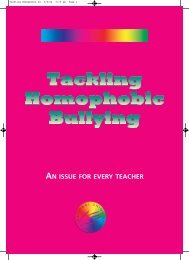Non-Normative Gender and Sexual Identities in Schools: - Schools Out
Non-Normative Gender and Sexual Identities in Schools: - Schools Out
Non-Normative Gender and Sexual Identities in Schools: - Schools Out
Create successful ePaper yourself
Turn your PDF publications into a flip-book with our unique Google optimized e-Paper software.
Why do we need a focus on homophobia <strong>and</strong> sexism?<br />
There are at least three reasons to suggest a focus on homophobia <strong>and</strong> sexism as<br />
<strong>in</strong>terrelated manifestations of a culture that privileges particular stereotypes of mascul<strong>in</strong>ity<br />
<strong>and</strong> fem<strong>in</strong><strong>in</strong>ity.<br />
Sexist bully<strong>in</strong>g is not just perpetrated by boys or men<br />
Sexist bully<strong>in</strong>g is predom<strong>in</strong>antly perpetrated by males upon females. Girls <strong>and</strong> young<br />
women are almost twice as likely to be on the child protection register for sexual abuse as<br />
boys <strong>and</strong> young men. Statistics also show that <strong>in</strong> the UK, two women per week are killed<br />
by a male partner or former partner, <strong>and</strong> that one <strong>in</strong> four women will be a victim of<br />
domestic violence <strong>in</strong> their lifetime.<br />
However, the Anti-Bully<strong>in</strong>g Alliance notes that sexist bully<strong>in</strong>g has ‘an impact on both<br />
genders, <strong>and</strong> can be perpetrated by both genders on opposite <strong>and</strong> same-gender victims’.<br />
The concept of sexism alone is not <strong>in</strong>clusive enough to facilitate such an awareness. In<br />
particular, the sexist bully<strong>in</strong>g of girls by other girls as part of establish<strong>in</strong>g conformity to<br />
dom<strong>in</strong>ant expectations of fem<strong>in</strong><strong>in</strong>ity <strong>and</strong> to the related boundaries of appropriate sexuality<br />
<strong>and</strong> sexual behaviour is not readily associated with the term sexism.<br />
Homophobic bully<strong>in</strong>g is not restricted to lesbian, gay <strong>and</strong> bisexual people<br />
Homophobic bully<strong>in</strong>g <strong>and</strong> abuse is not exclusively targeted at lesbian, gay <strong>and</strong> bisexual<br />
people, but also at those who are perceived to be lesbian, gay or bisexual, or who do not<br />
conform to exist<strong>in</strong>g sex/gender codes. The term ‘homophobia’, which is generally def<strong>in</strong>ed<br />
as the passive or active resentment or fear of someone who is lesbian, gay or bisexual, does<br />
not explicitly <strong>in</strong>clude a reference to a lack of conformity to stereotypical notions of<br />
mascul<strong>in</strong>ity <strong>and</strong> fem<strong>in</strong><strong>in</strong>ity. Although homophobia presupposes such stereotypes by<br />
identify<strong>in</strong>g behaviour that ‘deviates’ from these cultural norms as ‘gay’, we might wish to<br />
resist the homophobic notion of the existence of ‘gay behaviour’.<br />
Homophobic abuse of gay men frequently <strong>in</strong>volves language that is derogatory<br />
to females<br />
The vocabulary of homophobic abuse of gay males commonly consists of terms<br />
derogatory to females, such as ‘sissy’, ‘girl’, ‘faggot’, <strong>and</strong> ‘nancy boy’. This <strong>in</strong>terrelatedness<br />
of homophobia <strong>and</strong> sexism is also expressed <strong>in</strong> the regular <strong>and</strong> wholly pejorative use of the<br />
term ‘effem<strong>in</strong>ate’ to identify a ‘lack’ of mascul<strong>in</strong>ity <strong>in</strong> boys or men <strong>and</strong> at the same time<br />
stigmatise the ‘effete’ or ‘effem<strong>in</strong>ate’ male through the term’s simultaneous association with<br />
homosexuality.<br />
Tackl<strong>in</strong>g homophobia <strong>and</strong> sexism us<strong>in</strong>g the concept of heterosexism<br />
The concept of heterosexism <strong>in</strong>cludes a focus on both homophobia <strong>and</strong> sexism <strong>and</strong><br />
therefore enables us to account for the underly<strong>in</strong>g cultural prejudice aga<strong>in</strong>st lesbian, gay<br />
<strong>and</strong> bisexual people. This prejudice is firmly tied to dom<strong>in</strong>ant male <strong>and</strong> female identities that<br />
rely on heterosexuality as a norm.<br />
Heterosexism <strong>in</strong>cludes attitudes, behaviour <strong>and</strong> practices that constitute heterosexuality as<br />
the norm. At the same time, heterosexism reflects <strong>and</strong> encourages a dislike or feel<strong>in</strong>g of<br />
superiority towards girls <strong>and</strong> women.<br />
ATL believes that we can only successfully tackle sexism <strong>and</strong> homophobia by see<strong>in</strong>g them<br />
as two <strong>in</strong>tegral parts of the wider cultural problem of heterosexism. Heterosexism advocates<br />
<strong>and</strong> supports a narrowly def<strong>in</strong>ed set of heterosexual sex/gender identities that restrict<br />
everyone. Those who do not conform to these stereotypical notions of ‘mascul<strong>in</strong>ity’ <strong>and</strong><br />
‘fem<strong>in</strong><strong>in</strong>ity’ are frequently subjected to homophobic <strong>and</strong> sexist bully<strong>in</strong>g <strong>and</strong> abuse.







